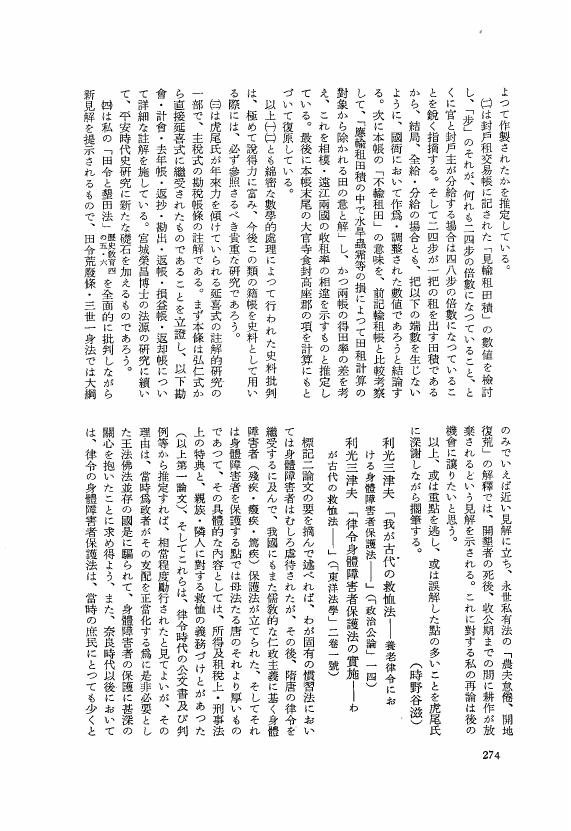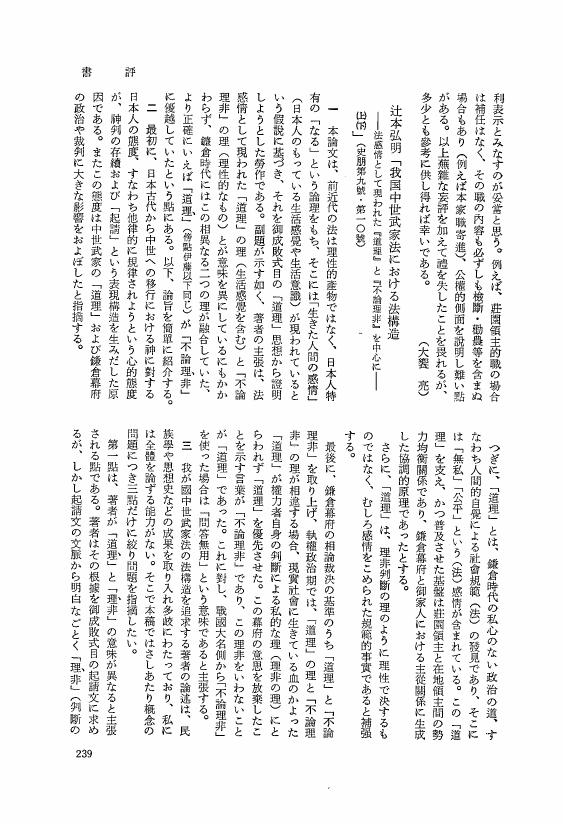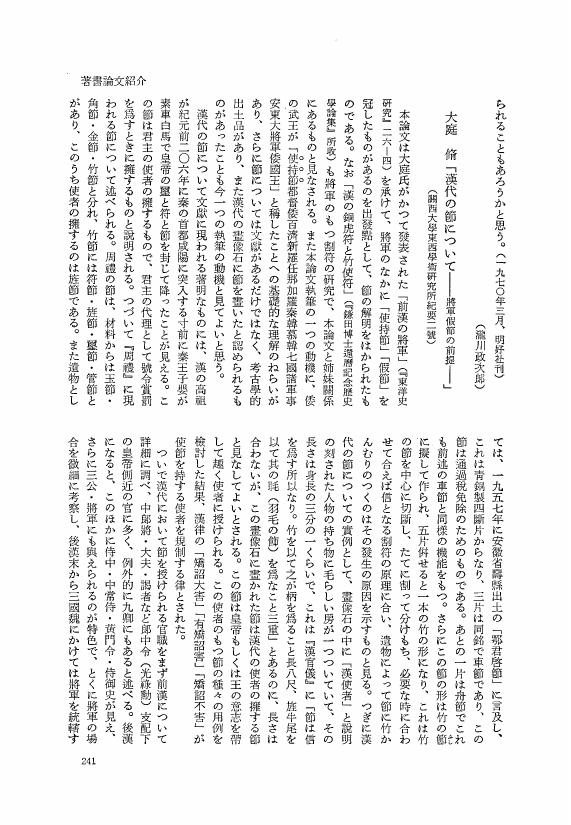2 0 0 0 可矜と可疑:清朝初期の朝審手続及び事案の分類をめぐって
- 著者
- 赤城 美恵子
- 出版者
- 法制史学会
- 雑誌
- 法制史研究 (ISSN:04412508)
- 巻号頁・発行日
- no.54, pp.25-59,en5, 2004
This article is a study on the introduction of the Court Assize (<I>Chaoshen</I> _??__??_) in early <I>Qing</I> dynasty with respect to three aspects of its background, procedure, and case-classification.<BR>In the Code (<I>Lüli</I> _??__??_) of <I>Qing</I> dynasty, capital punishments were expressly distinguished into decapitation, strangulation, and so on at the point of the punishment type, and also distinguished into <I>Lijue</I> (_??__??_) and <I>Jianhou</I> (_??__??_) at the point of the execution timing. The bureaucratic structure also functioned as the judicial structure. Each bureaucrat who would judge a case made it clear that the suspect had some criminal act; selected the suitable punishment according to <I>Lüli;</I> and reported to superior officer for his sanction. In capital cases, the emperor would finally judge. If it was a <I>Lijue</I> case, a person judged to death by the emperor was simultaneously ordered to execute; if it was a <I>Jianhou</I> case, on the other hand, he was not immediately executed. There was the revision procedure whether to be executed or not about <I>Jianhou</I> criminals. The revision procedure for <I>Jianhou</I> criminals in the prison of the Board of Punishment at the Metropolitan was called the Court Assize. The revision procedure in the local prison was called the Autumn Assize (<I>Qiushen</I> _??__??_).<BR>In ancient China, there was an idea that crimes should not be executed at spring and summer, except for special significant crimes that should be executed without delay. <I>Ming</I> dynasty classified each of capital crimes on <I>Lü</I> (_??_) whether to be executed without delay or not, and began the revision procedure about criminals of <I>Qiuhou-Chujue</I> (_??__??__??__??_) who were not executed until autumn.<BR>Just after entering Peking, <I>Qing</I> dynasty decided to distinguish between <I>Lijue</I> and <I>Jianhou</I> in local cases. Surely the local <I>Jianhou</I> cases were subject to the revision, but without <I>Qiuhou-Chujue</I>. Cases in the Metropolitan Area had neither such distinction nor such revision procedure. Since the Han bureaucrats regarded such inconsistency as the problem, they often requested to introduce Qiuhou-Chujue procedure and the distinction between Lijue and Jianhou in the Metropolitan cases. Finally, in Shunzhi (_??__??_) 10 (1653), Li-Huaxi (_??__??__??_), who was the Minister of the Board of Punishment explained the necessity of the reform of the procedure in view of political purpose of legal unity. Then it was decided to introduce such distinction into cases of the Metropolitan Area. On this opportunity, it was decided that all Jianhou cases were to be Qiuhou-Chujue and that the revision procedure should be carried out at the autumn execution in all districts.<BR>When Qing formed the Court Assize procedure based on that in Ming dynasty, Qing did not reproduce faithfully, but adapted it to the society and the bureaucratic structure which was mixed by the Manchuria and the Han. Thus the political system in early Qing dynasty was reflected in the practice of the Court Assize.<BR>The revision procedure had some case-classifications. In Court Assize, bureaucrats judged and selected suitable class for each criminal, and submitted the case for imperial sanction. Each Kejin and Keyi was one of the case-classifications of revision procedure. The former was used for comparatively slight cases of Jianhou; the latter was used for doubtful cases. Kejin or Keyi meant that the execution was not suitable for the criminal of that case. Because Kejin and Keyi had such resembled function, these two categories was confused, so that a term Jinyi (_??__??_) was seen at Ming. In some case, these two seem to substantially be confused. But, in materials, it also seems that bureaucrats distinguished Kejin from Keyi as the category of case-classifications. The seriousness of the case was the classification criterion.
- 著者
- 徳永 洋介
- 出版者
- 法制史学会
- 雑誌
- 法制史研究 (ISSN:04412508)
- 巻号頁・発行日
- vol.2000, no.50, pp.331-334, 2001-04-20 (Released:2009-11-16)
2 0 0 0 OA 「ヘブライ法における同害報復の刑罰に就いて」
- 著者
- 赤井 節
- 出版者
- 法制史学会
- 雑誌
- 法制史研究 (ISSN:04412508)
- 巻号頁・発行日
- vol.1955, no.5, pp.32-78,en2, 1955-06-05 (Released:2009-11-16)
The Old Testament, and the Pentateuch in particular, is generally recognized as the sole extant record that casts light on the ancient Hebrew law. And it is also generally known that the Petateuch is a compound of many records, which date back to various different periods in the Hebrew history.This is an attempt to clarify from various angles the lex talionis, generally known in the formula "an eye for an eye and a tooth for a tooth, " and to criticize the work of Professor D. Daube. The Old Testament, mainly the Pentateuch, was used as the basis of my study. In the Pentateuch, lex talionis is mentioned in Exodus, Deuteronomium and Leviticus. These records will be examined from a philological viewpoint and a casuistic viewpoint and also from the standpoint of the writers who penned these records. The significance of these three records is varied and the description in each of them has a different shade of meaning. In the conclusion of my study, I have tried to clarify the way of thinking that underlies the idea of lex talionis. In this part of my study, the Old Testament as a whole was discussed mainly from the philological point of view.It is needless to say that excellent researches of D. Daube, D. H. Muller, S. A. Cook and other outstanding scholars have given me a great aid to my study. In Japan, however, there are hardly any researches in this field, which are based on the original Hebrew text of the Old Testament (Biblia Hebraica). I hope, therefore, my study will be of some value to the scholars of legal history.
2 0 0 0 OA (書評)町田實秀著「多數決原理の研究」
- 著者
- 三戸 寿
- 出版者
- 法制史学会
- 雑誌
- 法制史研究 (ISSN:04412508)
- 巻号頁・発行日
- vol.1959, no.9, pp.309-310, 1959-03-30 (Released:2009-11-16)
2 0 0 0 OA (書評)中村修也著「「京職論―平安京行政機構研究の試み―」(「延喜式研究」一〇号)」
- 著者
- 井上 満郎
- 出版者
- 法制史学会
- 雑誌
- 法制史研究 (ISSN:04412508)
- 巻号頁・発行日
- vol.1996, no.46, pp.210-212, 1997-03-30 (Released:2009-11-16)
2 0 0 0 OA (書評)毛利利彦著「江藤新平――急進的改革者の悲劇――」
- 著者
- 三阪 佳弘
- 出版者
- 法制史学会
- 雑誌
- 法制史研究 (ISSN:04412508)
- 巻号頁・発行日
- vol.1988, no.38, pp.231-236, 1989-03-30 (Released:2009-11-16)
- 著者
- 前澤 伸行
- 出版者
- 法制史学会
- 雑誌
- 法制史研究 (ISSN:04412508)
- 巻号頁・発行日
- no.37, pp.318-320, 1987
- 著者
- 虎尾 俊哉
- 出版者
- 法制史学会
- 雑誌
- 法制史研究 (ISSN:04412508)
- 巻号頁・発行日
- vol.1960, no.10, pp.274-275, 1960-03-30 (Released:2009-11-16)
- 著者
- 高 友希子
- 出版者
- 法制史学会
- 雑誌
- 法制史研究 (ISSN:04412508)
- 巻号頁・発行日
- no.50, pp.376-380, 2000
2 0 0 0 OA シャイバーニー『アスル』の編纂過程
- 著者
- 柳橋 博之
- 出版者
- 法制史学会
- 雑誌
- 法制史研究 (ISSN:04412508)
- 巻号頁・発行日
- vol.58, pp.1-46,en3, 2009-03-30 (Released:2014-03-31)
カルダーによれば、九世紀の法学テキストが一般にそうであったように、現在我々が目にするような『アスル』のテキストは、最初に弟子が師の言葉を書き取り、それにたいしてその弟子自身またはそれ以後の編纂者が次々と加筆、修正、並べ替えなどの編集を積み重ねる過程を経て確定され、シャイバーニーの著作とされた。ハッラークも、法源学の著作を資料として用いて、九世紀末までの法学者は、「導出」によって学祖の説から二次的に導き出した説を、学祖の説と識別不能な形でテキスト中に取り込んだとしている。しかし両者とも、用いている資料に由来する制約から、そのような著述の方法がいつどのようにして始まったのかについては述べていない。本稿は、その過程を、カイロ写本、シャイバーニー(八〇五年没)『アスル』「賃約の書」を分析することによって推察する試みである。この写本の一部は、これまでに刊本になっている最終版『アスル』が成立する前の編纂段階を反映している点で、その編纂過程を知る上で有益な情報をもたらしてくれる。その分析の結果、つぎのような結論を得た。1.原『アスル』は、シャイバーニーの口述である。2.そのつぎの段階―編纂の前期―では、原『アスル』を補足・敷衍する形で設例が付け加えられるが、テキストとしては原『アスル』とは切り離された形で作成された3.最終段階―編纂の後期―では、テキストの混交が行われ、シャイバーニー以降に作成されたテキストが原『アスル』に埋め込まれている。このように、『アスル』の前期の編纂段階においては新しいテキストは古いテキストとは別個に作成され、また異なる文体が用いられたが、それ以降の編纂段階においてテキストの統一ないし混交が行われ、校訂本の多くの書に見られるようなテキストが確立したのである。このことは、前期の編纂者が学祖の説とそれ以降の学説を区別しようとしていたのにたいして、後期の編纂者には、学祖の説とそこから「導出」によって導かれる学説を全体として一つの体系―つまりはハナフィー派学説―とみなす傾向が見られると解することができよう。
- 著者
- 伊藤 一義
- 出版者
- 法制史学会
- 雑誌
- 法制史研究 (ISSN:04412508)
- 巻号頁・発行日
- vol.1976, no.26, pp.239-240, 1977-03-30 (Released:2009-11-16)
- 著者
- 森 洋
- 出版者
- 法制史学会
- 雑誌
- 法制史研究 (ISSN:04412508)
- 巻号頁・発行日
- vol.1985, no.35, pp.383-391, 1986-03-30 (Released:2009-11-16)
2 0 0 0 OA (書評)桑原朝子著「平安朝の漢詩と「法」―文人貴族の貴族制構想の成立と挫折」
- 著者
- 所 功
- 出版者
- 法制史学会
- 雑誌
- 法制史研究 (ISSN:04412508)
- 巻号頁・発行日
- vol.2007, no.57, pp.245-247, 2007 (Released:2013-04-01)
- 著者
- 神寶 秀夫
- 出版者
- 法制史学会
- 雑誌
- 法制史研究 (ISSN:04412508)
- 巻号頁・発行日
- vol.1997, no.47, pp.404-407, 1998-03-30 (Released:2009-11-16)
2 0 0 0 OA 近世中後期幕府の上方支配
- 著者
- 小倉 宗
- 出版者
- 法制史学会
- 雑誌
- 法制史研究 (ISSN:04412508)
- 巻号頁・発行日
- vol.2007, no.57, pp.85-122,en6, 2007 (Released:2013-04-01)
本稿では、近世中後期の江戸幕府において、公事方御定書とともに最重要の法源であった御仕置例類集を主にとりあげ、仕置に関することがらを中心に、関東とならぶ幕府の拠点地域である上方の支配を検討した。その際、上方の内部や江戸との間において、幕府役人が行政・裁判を処理する過程や権限に注目した。(1)幕府の上方役人は、伺とそれに対する指示という同じ過程のなかで、行政と裁判を一体的・連続的に処理し、すでに発生している問題を個別的に解決するとともに、今後発生する問題について一般的に対処するための規則や制度を設定・変更していた。(2)上方役人の伺には、上方の奉行より京都の所司代や大坂城代への伺(上方奉行伺)、所司代や大坂城代より江戸の老中への伺(所司代伺・大坂城代伺)、上方奉行より老中への伺(江戸上り伺)、の三通りがあった。また、上方奉行と老中のやりとりは、伺とそれに対する指示との両面において、所司代や大坂城代による監督・仲介のもとになされた。(3)所司代や大坂城代は、老中と同じ形式の文書を用いながら、上方奉行の伺に対して自ら決定・指示し、仕置をはじめとするさまざまな問題が上方の内部で処理されていた。延享元年(一七四四)に、仕置をめぐる所司代・大坂城代と上方奉行との関係が確立され、天明八年(一七八八)には、所司代や大坂城代が自ら指示しうる仕置の範囲は大幅に拡大された。(4)京都・大坂町奉行は、所司代や大坂城代のもと、それらの監督・担当する業務の全般にわたって調査・答申するという特別な役割を果たしていた。そうしたあり方は、老中のもとにある評定所のあり方と同様であり、上方における、所司代・大坂城代と京都・大坂町奉行の関係は、江戸における老中と評定所の関係と相似であった。
2 0 0 0 OA 榎村寛之氏の「書評」に応える
- 著者
- 水林 彪
- 出版者
- 法制史学会
- 雑誌
- 法制史研究 (ISSN:04412508)
- 巻号頁・発行日
- vol.58, pp.431-448, 2009-03-30 (Released:2014-03-31)
- 著者
- 布目 潮〓
- 出版者
- 法制史学会
- 雑誌
- 法制史研究 (ISSN:04412508)
- 巻号頁・発行日
- vol.1971, no.21, pp.241-242, 1972-03-30 (Released:2009-11-16)
2 0 0 0 OA (書評)杉山晴康著「日本法史概論」
- 著者
- 大竹 秀男
- 出版者
- 法制史学会
- 雑誌
- 法制史研究 (ISSN:04412508)
- 巻号頁・発行日
- vol.1981, no.31, pp.202-203, 1982-03-30 (Released:2009-11-16)
2 0 0 0 OA (書評)石井良助著「「刑罰の歴史」(日本)」
- 著者
- 平松 義郎
- 出版者
- 法制史学会
- 雑誌
- 法制史研究 (ISSN:04412508)
- 巻号頁・発行日
- vol.1954, no.4, pp.249-252, 1954-07-31 (Released:2009-11-16)
2 0 0 0 OA (書評)池田雄一著「「李〓の法経について」(中央大学文学部紀要(史学科)第二九号)」
- 著者
- 工藤 元男
- 出版者
- 法制史学会
- 雑誌
- 法制史研究 (ISSN:04412508)
- 巻号頁・発行日
- vol.1985, no.35, pp.321-323, 1986-03-30 (Released:2009-11-16)













